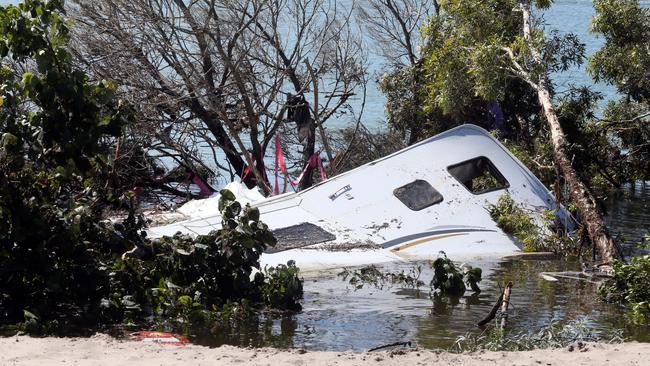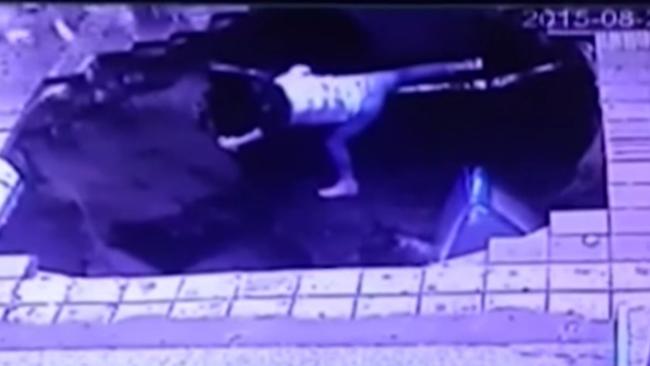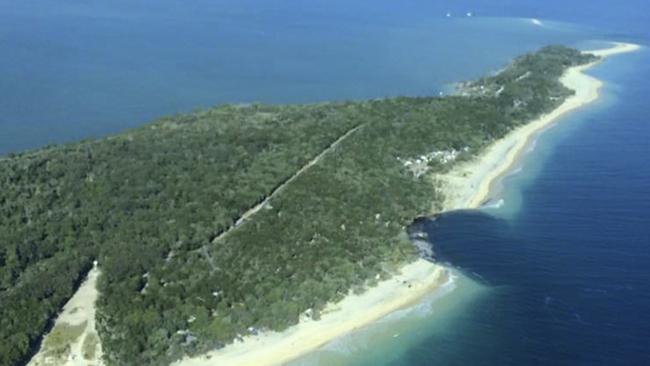Inskip Point ‘sinkhole’ joins a long list of other terrifying holes
SINKHOLES capable of swallowing cars, concrete and caravans are suddenly opening up and leaving gaping holes in their wake. Where will the next one be?
IT would appear the earth is conspiring against us.
The giant hole that opened up on Queensland’s Sunshine Coast this week, which gobbled up a caravan, a car and a whole lot of tents and coastline, was the latest in a long list of times the earth has suddenly opened up and left a scary, gaping hole in its wake.
“Sinkholes” sent communities into a panic in Caulfield in Victoria yesterday and in the Sydney suburbs of Harris Park in May, Illawong in June and Bilgola last year.
Another big one opened up last year in Swansea, near Newcastle, as well as on a man’s property in Darwin.
A woman even fell into a 3m sinkhole while hanging out washing in her Melbourne backyard.
You’d be forgiven for thinking the ground below you could open up right now, sending you spiralling into the depths below.
What is going on? Is something terribly wrong?
The short answer is: not at all.
Each of those headline-making events were uncommon, unlinked and easily explained, Stephen Fityus, geotechnical engineering professor at the University of Newcastle, told news.com.au.

“Each one would have an explanation, each would be a slightly different explanation, and there would be no connection between them,” he said.
And while they might have been sudden, scary and destructive, those weren’t even necessarily sinkholes. True sinkholes usually occur in limestone bedrocks, although mining and engineering can trigger them, too.
Prof Fityus said the so-called Swansea Heads sinkhole happened at an old mine shaft that was only partially backfilled, so over time, the surface opened up and the hole reappeared.
“It was a rarity in that it was so deep because there aren’t that many shafts in Newcastle — they didn’t drill a lot of vertical holes,” he said.
“But there’s no correlation between that hole and what happens anywhere else. We just had a lot of rain around that time and that rain softened up the ground … and the plug fell in.
“With roads collapsing under water pipes, that happens a lot too, but that’s not related to anything that happened at Inskip Point or anything that happens in limestone craters. It’s very simply open pipes sucking soil away and undermining the surface.
“And that is more likely to happen where you’ve got an anomalously high amount of rainfall, and the pipes are working harder because they’re carrying more water.”

THEN WHAT ARE SINKHOLES?
In basic terms, a sinkhole happens in cast environments with thick layers of limestone. When water seeps through cracks in the limestone, they eventually cause underground cave systems. And when the caves grow too big, and the ground above them too thin, they collapse — and there’s your sinkhole.
“That explains the kind of thing Guatemala, and in the US in Florida,” Prof Fityus said.
“Some of the big, round water-filled holes around Mt Gambia in South Australia are old sinkholes. Those sorts of things are quite common out there in the world.”
There are vast areas of Australia that are cast environments. The Nullarbor Plain is underlaid by white limestone deposits, and there is limestone cast with underground cave systems in areas close to the Northern Territory-Queensland border.
“Theoretically, those areas could drop,” Prof Fityus said.

“These things happen over geological time, generally with geological frequency, and very little we do as human beings influences when they will or won’t happen. They’re just a naturally occurring thing, like volcanoes erupting — they just happen when they happen.”
Happily, though, it’s not very likely you’ll be around whatever it happens.
“The risks differ from place to place and nobody needs to worry,” Prof Fityus said.
“It’s pretty fair to say that probably only a good 90 per cent of Australia’s land area is totally not prone to any form of sinkhole formation whatsoever, except where poor engineering works might lead to a localised cavity.”
And whatever happened at Inskip Point on Saturday night, that wasn’t a sinkhole.
“For the ground to open up and make a proper sinkhole there’s got to be somewhere for the stuff to go, and the ground is not full of holes like Swiss cheese,” Prof Fityus said.
“It will be in cast environments in some places, and yes, it is like Swiss cheese where we’ve mined it out but we know where those risk areas are.”

SO WHAT DID HAPPEN AT INSKIP POINT?
The monster hole that sent campers scrambling for safety was deemed by experts as to be some kind of underwater landslide. Prof Fityus agrees.
“The Inskip Point thing is an ongoing coastal geomorphic process, and they happen all up and down the coast and they happen all the time,” he said.
“Sand comes in, sand goes. I think in that instance people have to be mindful that the coastlines are a dynamic environment and things are going to change. But that’s unrelated to true sinkholes.”
And neither are they cause for alarm.
“These things are explicable, they’re unusual, they’re anomalous,” Prof Fityus said.
“We lost a caravan at Inskip Point but how many people take caravans along the coast of Australia every year, and camp at the beach, and how few of those are affected by an event?
“People don’t need to panic, people don’t need to fear. There’s probably much more chance of getting taken by a shark in the beach than by leaving your caravan by the beach.”
And whatever you do, don’t get started on the doomsday warnings.
“There are a lot of people looking for deeper, sinister meanings, people looking to read stuff into it, like mother Earth getting angry and wanting to get revenge,” Prof Fityus said. “I think that’s very much over dramatising what’s going on.”




